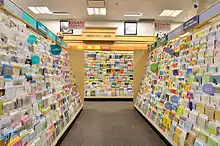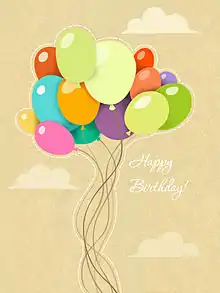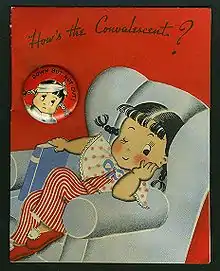Greeting card
A greeting card is a piece of card stock, usually with an illustration or photo, made of high quality paper featuring an expression of friendship or other sentiment. Although greeting cards are usually given on special occasions such as birthdays, Christmas or other holidays, such as Halloween, they are also sent to convey thanks or express other feelings (such as condolences or best wishes to get well from illness).


Greeting cards are usually packaged with an envelope and come in a variety of styles. There are both mass-produced and handmade versions available and they may be distributed by hundreds of companies large and small. While typically inexpensive, more elaborate cards with die-cuts, pop-ups, sound elements or glued-on decorations may be more expensive.
Hallmark Cards and American Greetings, both U.S.-based companies, are the two largest producers of greeting cards in the world today.
In Western countries and increasingly in other societies, many people traditionally mail seasonally themed cards to their friends and relatives in December. Many service businesses also send cards to their customers in this season, usually with a universally acceptable non-religious message such as "happy holidays" or "season's greetings."
Types of greeting cards

Counter cards: Greeting cards that are sold individually. This contrasts with boxed cards.[1]
- Standard
- A standard greeting card is printed on high-quality paper (such as card stock), and is rectangular and folded, with a picture or decorative motif on the front. Inside is a pre-printed message appropriate for the occasion, along with a blank space for the sender to add a signature or handwritten message. A matching envelope is sold with the card. Some cards and envelopes feature fancy materials, such as gold leaf, ribbons, or glitter.
- Handmade
- A Handmade card[2] is a card which includes a production stage or a feature that is made by hand. The term covers a wide range of products including not only for example, applique items or ribbons but also pop-up and 3-D cards as well as cards made with mixed materials. The term "Handmade" is applied both to cards made by amateurs and to volume-production cards that include stages made by hand.
- Photo
- A photo card is a card which features a photograph chosen by the sender. There are two main types of photo card. The first is the photo insert card which is designed to display a sender's own photo. Depending on the card design, the photo is stuck to the card, clipped to the card or slid into a pocket in the card into which a hole has been cut to act as a frame. The second type is the printed photo card, in which the photo is combined with artwork and printed directly onto the face of the card. Both types are popular for sending holiday greetings such as Christmas, Hanukkah, and for baby showers, where the sender wishes to send a memento of their own family. See also Personalised cards.
- Personalised
- A personalised card is a card which is personalised with the sender's own pictures or a personal audible message. Websites using special print-personalisation technology, such as Moonpig, allow consumers to personalise a card which is then printed and sent directly to the recipient. Sound personalization is also possible using a small recording device called a Botski, which is a sticker-based recordable medium allowing users to record songs, sounds or spoken words and include them in a greeting card.
- Reusable
- These are greeting cards for the budget conscious. There are two common formats for reusable cards. Firstly, there are cards with slits in them positioned to hold pages. Secondly, there are notepad style cards where pages stick to the back of the cards. The pages that have been used for reusable cards can be removed after being received and fresh pages can be used to reuse the cards.[3]
- Sound-based or Musical
- Some greeting cards play music or other sound when they are opened. They are commonly 3D handmade cards which play traditional celebration songs such as "Happy Birthday To You.” They also may be personalized using a Botski which is a small, sticker-based recordable medium which users can record their own music, sounds or voice greeting and apply it to a card.[4]
- Electronic
- (also called e-cards) Greeting cards can also be sent electronically. Flash-based cards can be sent by email, and many sites such as Facebook enable users to send greetings. More recently, services have launched which enable users to send greetings to a mobile phone by text message or use mobile app for this purpose such cards are called Mobile E-cards or MCards. Many of these electronic services offer open or anonymous chat, to enable further discussion.
- Quilling Cards
- Quilling cards are greeting cards that contain a Quilled design on the front of the card. Quilling is an artform where strips of paper are rolled to make intricate designs. These cards are unique and handcrafted and are often framed as works of art.
- Pop-up
- Pop-up cards are normally cards that, once opened, have a picture coming outward, giving the reader a surprise. Pictures and printed messages in greeting cards come in various styles, from fine art to humorous to profane. Non-specific cards, unrelated to any occasion, might feature a picture (or a pocket to paste in a personal photograph) but no pre-printed message. Paper Pop Cards has a patent for detachable pop-up cards[5] which lets the pop-up be saved as Keepsake.:Pop Up card designs are inspired by the Kirigami art form, which originated in Japan. This card style has spread to the US, U.K., India and elsewhere. In Shark Tank episode 605 in season 11, the startup Lovepop cards founded by Wombi Rose and John Wise appeared with Kirigami art inspired pop up cards and raised $300,000 of funding.[6][7]
Printable
- Also known as digital greeting cards, they can be found online through shopping platforms such as Etsy and some blogs. Usually available in the form of a PDF document, the design for a card can be printed out at home or a local print shop. Printable cards have allowed designers to make cards readily available to customers all over the world.
Get Well
- A get-well card is a greeting card which is sent to someone when they are ill.[8] Their use in the case of chronic and terminal illness is problematic because the patient may not be expected to recover but they may still offer comfort to the invalid.[9][10]
Fabric
The concept of a khaki fabric card appeared in 1899 during the first Christmas of the Boer War and was issued by a business in Glasgow. In New Zealand, it was not uncommon to receive a khaki greeting card, even the premier, RJ Seddon is said to have received one. An example of a fabric card is held by the Auckland War Memorial Museum, and is a small square of fabric with a heavy fringe created by threads with a hand written greeting. [11]
History

The custom of sending greeting cards can be traced back to the ancient Chinese who exchanged messages of good will to celebrate the New Year, and to the early Egyptians, who conveyed their greetings on papyrus scrolls.[12] By the early 15th century, handmade paper greeting cards were being exchanged in Europe. The Germans are known to have printed New Year's greetings from woodcuts as early as 1400, and handmade paper Valentines were being exchanged in various parts of Europe in the early to mid-15th century, with the oldest Valentine in existence being in the British Museum.[12][13] The card was written to Bonne of Armagnac by her husband, Charles Duke of Orleans, who was imprisoned in the Tower of London at the time. Not surprisingly, its message is rather downbeat. Its opening reads: ‘I am already sick of love / my very gentle Valentine.’[14]
By the 1850s, the greeting card had been transformed from a relatively expensive, handmade and hand-delivered gift to a popular and affordable means of personal communication, due largely to advances in printing, mechanization, and a reduction in postal rates with the introduction of the postage stamp.[15] This was followed by new trends like Christmas cards, the first of which appeared in published form in London in 1843 when Sir Henry Cole hired artist John Calcott Horsley to design a holiday card that he could send to his friends and acquaintances. In the 1860s, companies like Marcus Ward & Co, Charles Goodall & Son, and Charles Bennett began the mass production of greeting cards. They employed well-known artists such as Kate Greenaway and Walter Crane as illustrators and card designers. The extensive Laura Seddon Greeting Card Collection from the Manchester Metropolitan University gathers 32,000 Victorian and Edwardian greeting cards and 450 Valentine's Day cards dating from the early nineteenth century, printed by the major publishers of the day.[16]
Technical developments like color lithography in 1930 propelled the manufactured greeting card industry forward. Humorous greeting cards, known as studio cards, became popular in the late 1940s and 1950s.
In the 1970s, Recycled Paper Greetings, a small company needing to establish a competing identity against the large companies like Hallmark Cards, began publishing humorous, whimsical card designs with the artist's name credited on the back. This was away from what was known as the standard look (sometimes called the Hallmark look.)
During the 1980s, reduced costs of small batch printing and die cutting together with a growing taste for handmade cards made it economically possible for smaller niche companies to set up in competition with the large established brands. Innovative companies such as Nobleworks and Meri Meri[17] grew from their foundation in the 1980s to becoming significant influencers in the industry. A thriving market was established for what were now called "alternative" greeting cards. The name stuck even though these "alternative" cards grew to embrace a vast range of styles and ultimately changed the look of the industry.
The largest recorded number of greeting cards sent to a single person went to Craig Shergold, a beneficiary/victim of chain letters and later chain emails.
Economic effects
In the United Kingdom, it is estimated that one billion pounds are spent on greeting cards every year, with the average person sending 55 cards per year.[18] In the United States, approximately 6.5 billion greeting cards are bought each year, at a total cost of more than US$7 billion.[1]
In the United States, a counter card typically sells for US$2 to $4.[1] Boxed cards, which are popular for Christmas cards or other times when many cards are sent, tend to cost less.
Greeting Card Association
The Greeting Card Association is a US trade organization representing the interests of greeting card and stationery manufacturers.[19] John Beeder, former president of the Greeting Card Association, says greeting cards are effective tools to communicate important feelings to people you care about: "Anyone feels great when they receive an unexpected card in the mail. For me, there’s nothing like a greeting card to send a special message. I’m proud to be a part of an industry that not only keeps people connected, but uses both imagery and the power of words to help us express our emotions.”
Louie Awards
Since 1988, the Greeting Card Association has held an annual award ceremony for the best greetings cards published that year. The awards are called Louies in recognition of Louis Prang, described as the Father of the American Christmas Card.[20]
Postcards
Postcards, which are single-sided without the fold, can function in a manner somewhat similar to greeting cards. Postcards appeared fairly early on in the history of the postal service as a cheaper way of sending messages, especially those of a tourist nature.
See also
References
- "About Greeting Cards - General Facts". Greeting Card Association. Archived from the original on 24 December 2013. Retrieved 22 December 2013.
- "Handmade Greeting Card Ideas". gocrafta.com. Retrieved 2020-08-24.
- "5 Creative Holiday Cards that Won't End up in the Landfill".
- United States Patent & Trademark Office. Botski Registered Trademark Archived 2022-12-06 at the Wayback Machine. Retrieved 3/2/21.
- "US Patent Application for ARTICLE WITH REMOVABLE THREE-DIMENSIONAL OBJECT Patent Application (Application #20180102071 issued April 12, 2018) - Justia Patents Search". patents.justia.com. Retrieved 2019-01-09.
- O'Brien, Kelly J. (January 2018). "'Shark Tank' success story Lovepop raises $12.5M from Highland Capital".
- "Wombi Rose and John Wise". Stationery Trends Magazine. 29 July 2019. Retrieved 2021-01-11.
- The encyclopedia of ephemera, Routledge, 2000, pp. 166, 271, ISBN 978-0-415-92648-5
- "The stay ill card", British Medical Journal, 315: 1125, 1997, doi:10.1136/bmj.315.7116.0h, S2CID 71174001
- Ernest Dudley Chase (1956), "Sunshine for the Shut-In and Get-Well cards for the Ill", The romance of greeting cards, pp. 148–152
- Romano, Gail. "A khaki valentine". Auckland Museum. Retrieved 7 June 2021.
- "The History of Greeting Cards". Souvenirs, Gifts, & Novelties. 50 (7): 254–255. October 2011.
- Michele Karl (January 2003). Greetings With Love: The Book of Valentines. Pelican Publishing. p. 19. ISBN 978-1-56554-993-7.
- "Greeting Cards - History, Origins & Uses". LEMON LOCO. Retrieved 2020-11-07.
- "The British Postal Museum & Archive — Rowland Hill's Postal Reforms". Archived from the original on 2014-12-24. Retrieved 2010-09-11.
- "MMU Special Collections - Victorian Ephemera". Manchester Metropolitan University. Retrieved November 8, 2013.
- "Greeting cards take Belmont company on a successful ride". 25 November 2005.
- Sean Coughlan (12 October 2006). "Card sharps". BBC News. Retrieved 2006-10-14.
- "About the GCA". 17 November 2015.
- "Greeting Card Association -".